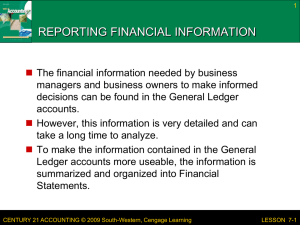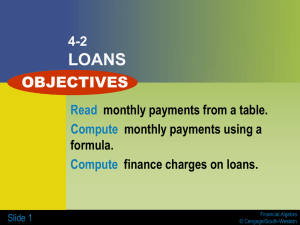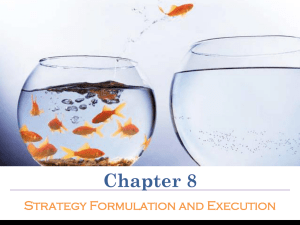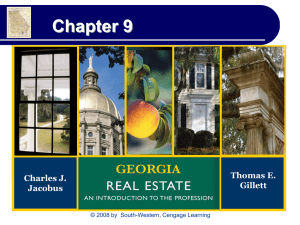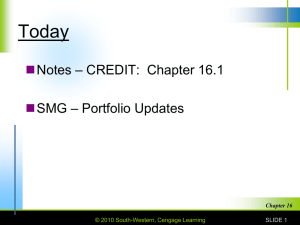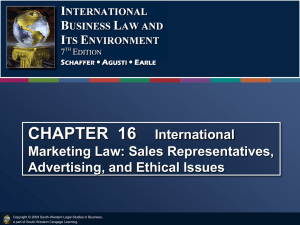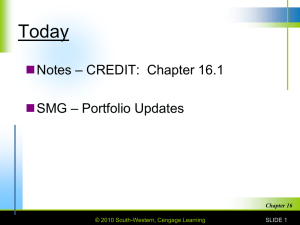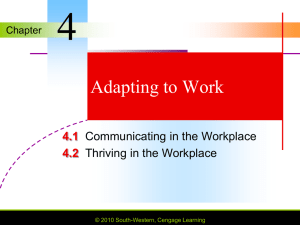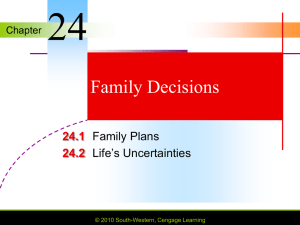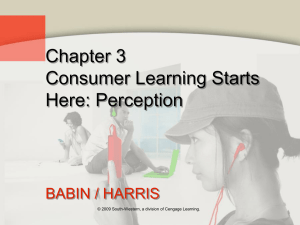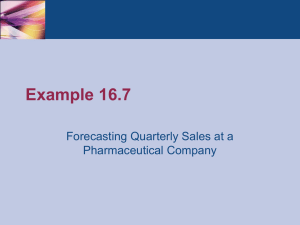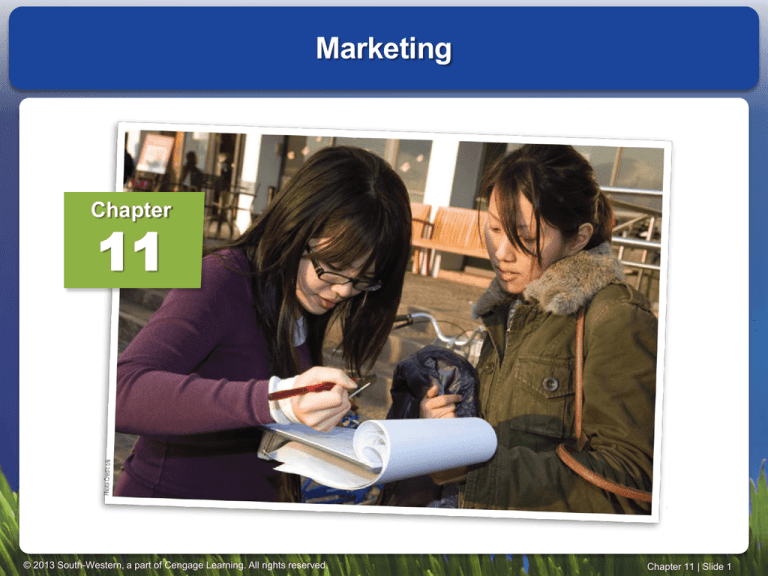
Marketing
Chapter
11
© 2013 South-Western, a part of Cengage Learning. All rights reserved.
Chapter 11 | Slide 1
Marketing is About Managing Customer
Relationships
Relationship marketing: establishing long-term,
mutually satisfying buyer-seller relationships
Customer relationship management (CRM):
using information about customers to create marketing
strategies that develop and sustain desirable
customer relationships
Customer lifetime value: a combination of purchase
frequency, average value of purchases, and brandswitching patterns over the entire span of a
customer’s relationship with a company
© 2013 South-Western, a part of Cengage Learning. All rights reserved.
Chapter 11 | Slide 2
The Marketing Concept
A business philosophy that a firm should provide
goods and services that satisfy customers’ needs
through a coordinated set of activities that allows
the firm to achieve its objectives
© 2013 South-Western, a part of Cengage Learning. All rights reserved.
Chapter 11 | Slide 3
The Marketing Concept (cont.)
How did the marketing concept come about?
• Industrial revolution through the early
twentieth century
–
Business effort directed toward production to meet
great demand
• 1920s
–
–
Production began to exceed demand
Business efforts included selling goods by advertising and
hiring larger sales forces
• 1950s
–
Business efforts also focused on satisfying
customers’ needs
© 2013 South-Western, a part of Cengage Learning. All rights reserved.
Chapter 11 | Slide 4
Evolution of the Marketing Concept (cont.)
Production Orientation
1850
Marketing Orientation
Sales Orientation
1900
1950
2000
Source: Adapted from William M. Pride and O.C. Ferrell, Foundations of Marketing, 3rd ed., © 2009 by Houghton Mifflin
Company. All rights reserved.
© 2013 South-Western, a part of Cengage Learning. All rights reserved.
Chapter 11 | Slide 5
Utility
The ability of a good or service to satisfy
a human need
• Form utility: created by converting production
inputs into finished products
• Place utility: created by making a product available
at a location where customers wish to purchase it
• Time utility: created by making a product available
when customers wish to purchase it
• Possession utility: created by transferring title
(or ownership) of a product to a buyer
© 2013 South-Western, a part of Cengage Learning. All rights reserved.
Chapter 11 | Slide 6
Types of Utility
© 2013 South-Western, a part of Cengage Learning. All rights reserved.
Chapter 11 | Slide 7
Amazon.com
An example of excellent distribution (“Place
Utility”)
Amazon.com excels at providing “place”
utility
• Amazon Fulfillment Center
• Amazon offers same day delivery?
• If it’s same day delivery, or next-day, doesn’t that
also provide “time” utility?
© 2013 South-Western, a part of Cengage Learning. All rights reserved.
Chapter 11 | Slide 8
The 4 P’s of the Marketing Mix
Putting the marketing concept into practice-
The 4 P’s of the Marketing Mix:
–
Provide a PRODUCT that will satisfy customers
– PRICE the product at an acceptable and profitable
level
– PROMOTE the product to potential customers
– Ensure distribution (PLACE) for product availability
when and where wanted
Modify the 4 P’s as needed to satisfy the
customer
© 2013 South-Western, a part of Cengage Learning. All rights reserved.
Chapter 11 | Slide 9
Markets and Their Classification
Market
• A group of individuals or organizations, or both, that need
products in a given category and who are ready, willing and
able (have the authority) to buy.
Consumer markets
• Purchasers and/or household members who intend to
consume or benefit from the purchased products and who
do not buy products to resell them.
Business-to-business (industrial) markets
• Producer, reseller, governmental, and institutional
customers that purchase specific kinds of products for use in
making other products for resale or for day-to-day
operations
© 2013 South-Western, a part of Cengage Learning. All rights reserved.
Chapter 11 | Slide 10
Business-to-business Markets
Producer markets
• Individuals and business organizations that buy
products to use in the manufacture of other products
Reseller markets
• Intermediaries such as wholesalers and retailers that
buy finished products and sell them for a profit
Governmental markets
• Buy goods and services to maintain operations and
provide citizens with products such as highways,
education, utilities, defense
Institutional markets
• Churches, not-for-profit private schools and hospitals,
civic clubs, charitable organizations
© 2013 South-Western, a part of Cengage Learning. All rights reserved.
Chapter 11 | Slide 11
Developing Marketing Strategies
Marketing strategy……a strategy is like a map. It
shows how will you get from point A to point B.
• A plan that will enable an organization to make
the best use of its resources and advantages to
meet its objectives
• Consists of:
1. Selecting the target market.
2.
Creating the 4 P’s of the marketing mix to satisfy
the target market.
© 2013 South-Western, a part of Cengage Learning. All rights reserved.
Chapter 11 | Slide 12
Developing Marketing Strategies (cont.)
Target market selection and evaluation
• Target market
–
A group of individuals, organizations, or both for which
a firm develops and maintains a marketing mix suitable
for the specific needs and preferences of that group
• Market segment
–
A group of individuals or organizations within a market
that share one or more common characteristics
• Market segmentation
–
The process of dividing a market into segments and
directing a marketing mix at a particular segment or
segments rather than at the total market
© 2013 South-Western, a part of Cengage Learning. All rights reserved.
Chapter 11 | Slide 13
Common Bases of Market Segmentation
© 2013 South-Western, a part of Cengage Learning. All rights reserved.
Chapter 11 | Slide 14
Advertisers’ Classification
of Audiences
Name
Millennials
Gen Xers
Boomers
Matures
Age
Needs
Influencer
Tech Savvy
Media saturated,
ethnically
diverse
30-45
Media Savvy
More cynical
than millennials
45-64
Avid
Consumers
Deny aging
process
65+
Practical,
pragmatic
Money
conscious
<30
Source: “Audience Research,” MediaKnowAll, http://www.mediaknowall.com/Advertising/research.html. Accessed 10/10/11.
© 2013 South-Western, a part of Cengage Learning. All rights reserved.
Chapter 11 | Slide 15
The Marketing Mix and the
Marketing Environment
© 2013 South-Western, a part of Cengage Learning. All rights reserved.
Chapter 11 | Slide 16
Developing a Marketing Plan
A written document that specifies an organization’s
resources, objectives, strategy, and implementation
and control efforts to be used in marketing a specific
product or product group
Elements of a marketing plan
•
•
•
•
•
•
•
•
Executive summary
Environmental analysis
Strengths and weaknesses
Opportunities and threats
Marketing objectives
Marketing strategies
Marketing implementation
Evaluation and control
© 2013 South-Western, a part of Cengage Learning. All rights reserved.
Chapter 11 | Slide 17
Components of the Marketing Plan
© 2013 South-Western, a part of Cengage Learning. All rights reserved.
Chapter 11 | Slide 18
Sales Forecasting
Sales forecast
• An estimate of the amount of a product that an
organization expects to sell during a certain period of
time based on a specified level of marketing effort
© 2013 South-Western, a part of Cengage Learning. All rights reserved.
Chapter 11 | Slide 19
Marketing Information
Marketing information system
• A system for managing marketing information that is
gathered continually from internal and external sources
Internal data sources
• Sales figures, product and marketing costs, inventory,
sales force activities
External data sources
• Suppliers, intermediaries, customers, competitors,
economic conditions
Outputs
• Sales reports, sales forecasts, buying trends,
market share
© 2013 South-Western, a part of Cengage Learning. All rights reserved.
Chapter 11 | Slide 20
The Six Steps of Marketing Research
© 2013 South-Western, a part of Cengage Learning. All rights reserved.
Chapter 11 | Slide 21
Using the Internet
The American Marketing Association’s
website is an excellent resource for
marketing information.
http://www.marketingpower.com
© 2013 South-Western, a part of Cengage Learning. All rights reserved.
Chapter 11 | Slide 22
Types of Buying Behavior
The decisions and actions of people involved in
buying and using products
Consumer buying behavior
• The purchasing of products for personal or household
use, not for business purposes
Business buying behavior
• The purchasing of products by producers, resellers,
governmental units, and institutions
© 2013 South-Western, a part of Cengage Learning. All rights reserved.
Chapter 11 | Slide 23
Consumer Buying Decision Process and
Possible Influences on the Process
© 2013 South-Western, a part of Cengage Learning. All rights reserved.
Chapter 11 | Slide 24
Why Do Consumers Buy?
They have a use for the product.
They like the convenience a product offers.
They believe the purchase will enhance
their wealth.
They take pride in ownership.
They buy for safety.
© 2013 South-Western, a part of Cengage Learning. All rights reserved.
Chapter 11 | Slide 25
Where Do Consumers Buy?
Influences on where to buy
• Perception of the store
• General impressions of an establishment’s
products, prices, and sales personnel
• Types of retail outlets
–
Specialty store, department store, discount store
• Location
• Product assortment
• Services such as credit terms, return privileges,
free delivery
© 2013 South-Western, a part of Cengage Learning. All rights reserved.
Chapter 11 | Slide 26
When Do Consumers Buy?
When buying is most convenient
Brick and mortar businesses-Hours have
stretched to include evenings, holidays, and
Sundays
Online shopping- 24/7 from anywhere there
is an internet connection
© 2013 South-Western, a part of Cengage Learning. All rights reserved.
Chapter 11 | Slide 27
Chapter Quiz
1. The utility created by transferring title of a
product to the buyer is called __________
utility.
A.
B.
C.
D.
E.
form
time
production
place
possession
© 2013 South-Western, a part of Cengage Learning. All rights reserved.
Chapter 11 | Slide 28
Chapter Quiz
2. J.C. Penney is considered to be a member of
which type of market?
A.
B.
C.
D.
E.
Business-to-business
Reseller
Consumer
Producer
Institutional
© 2013 South-Western, a part of Cengage Learning. All rights reserved.
Chapter 11 | Slide 29
Chapter Quiz
3. The ingredient of the marketing mix
concerned with product design, brand names,
packaging, and warranties is
A.
B.
C.
D.
E.
pricing.
quality.
product.
distribution.
promotion.
© 2013 South-Western, a part of Cengage Learning. All rights reserved.
Chapter 11 | Slide 30
Chapter Quiz
4. All of the following are true of marketing plans
except that
They should not be modified.
They should include task scheduling.
They should specify task objectives.
They should describe the firm’s current
situation.
E. They should focus on a particular product or
product group.
A.
B.
C.
D.
© 2013 South-Western, a part of Cengage Learning. All rights reserved.
Chapter 11 | Slide 31

